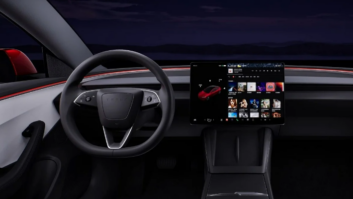Wi-Fi on Wheels: The Connected Car
Nov 1, 2014 9:00 AM, Shane Toven, Editor
Aside from the office, think about where you spend the most time listening to radio. Studies show that the car consistently tops the list of locations where radio and other audio content is consumed.

1999 GM Radio with Cassette and External CD Player
While the car radio has remained largely unchanged over the years, one of the biggest shifts has been the use of external media sources in the car. Initially, manufacturers started to integrate technologies such as cassette and CD to allow listeners to bring their personal media collections into the car, assuming it was in whatever format the car radio happened to accommodate. As media technologies started to evolve faster than car radios did, we soon saw devices such as cassette adapters and RF modulators, which allowed users to bring other media sources into the car.
The biggest game changer in recent history, however, has been the introduction of the smartphone. Consumers rapidly started to bring their smartphones (and the media content from those devices) into their cars. Car manufacturers responded by adding auxiliary input jacks, followed soon by USB and Bluetooth integration. This integration was the beginning of truly merging the functions of the smartphone with those provided by the entertainment system in the car.

2015 GM MyLink with radio and media buttons
In the past few years, the dashboard interface has taken a radical shift. Since the invention of the car radio, a basic �two-knob� interface for �volume� and �tuning� has been the norm, perhaps with a few additional controls for other functions. While those two basic controls may still exist, a large LCD touchscreen that integrates functions such as climate control and other vehicle systems is now standard equipment in many new cars.
Now that the car (like the smartphone) has a large LCD touchscreen interface, the next logical progression was to further integrate the two. Many car entertainment systems will at the very least control music playback from the smartphone while displaying title and artist information, in addition to the obvious function of safely handling phone calls through the car”s audio system. More advanced systems provide direct integration with streaming music apps on the smartphone such as Pandora. These changes have moved the control of apps from the smartphone itself to the car”s entertainment system.
Car manufacturers have continued to build on this approach. The latest systems offer not only control of smartphone apps, but can utilize the modem in the smartphone to provide a data link for navigation, traffic, audio streaming, vehicle diagnostics, and other applications. Some vehicles even forego using the smartphone”s modem altogether by integrating their own modem. GM recently introduced systems that essentially turn the vehicle into a �rolling Wi-Fi hotspot.�
Where does all of this leave radio in the new �connected� car? With a few notable exceptions, manufacturers continue to include AM and FM radio in the dash as an available source for the most part. That being said, as a broadcaster, communication with car dealers about what options are available in new cars, and education of listeners is key. It may be getting more difficult in many of these vehicles to find �radio� among the myriad of new listening options so it is important to be informed in order to keep listeners connected to your station in their new car. I would encourage you to look at test-driving a few 2015 model year cars. You might be rather surprised about what is and is not available on the new �digital dashboard.�












